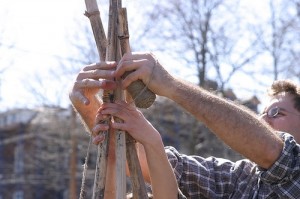Urban Green Spaces Can Nourish Us Even More
Posted in Exhibitions, The Edible Garden on August 18 2009, by Plant Talk
 |
Josh Viertel is president of Slow Food USA. He will discuss slow food and the sustainable food movement at this Thursday’s Edible Evening. |
 I’ve been a farmer and now I live in a city. A really big city. It was an easy decision to move to New York to run Slow Food USA. I have never been presented with a more exciting opportunity. But trading my big garden for Brooklyn this past fall was hard. Cities have their up sides. Particularly this city. I am blown away by the music, art, food, and friends in close proximity. Though I miss living out of my own garden, the farmers markets in New York bring me in contact with real food and real people who grow it. And the fish vendor has changed my life. More than anything, though, I am touched by the green space in New York.
I’ve been a farmer and now I live in a city. A really big city. It was an easy decision to move to New York to run Slow Food USA. I have never been presented with a more exciting opportunity. But trading my big garden for Brooklyn this past fall was hard. Cities have their up sides. Particularly this city. I am blown away by the music, art, food, and friends in close proximity. Though I miss living out of my own garden, the farmers markets in New York bring me in contact with real food and real people who grow it. And the fish vendor has changed my life. More than anything, though, I am touched by the green space in New York.
When our concrete landscape tires me, Greenwood Cemetery, Prospect Park, and The New York Botanical Garden all make it possible to slip back into a quasi-natural world. They aren’t strictly natural places—the human hand is all over them—but nature happens there. And the overlay between nature and culture makes the two indistinguishable. As it should be.
But in our city’s green spaces there is one aspect of this link between nature and culture that I miss. It is the oldest one. It is food growing. Urban community gardens and rooftop farms do this beautifully, but their reach is limited when compared to the iconic green spaces in our cities—Prospect Park, Central Park. When we enter these spaces we enter an environment where nature is idealized and where the human hand intervenes to make ballparks, but not food. This teaches a strange lesson to city dwellers. It teaches that the natural world is for inspiration (beautiful, without humans) or it is for recreation (skate trails, t-ball), but it is not for food. (Some do grill or picnic in the park, and I applaud them, but this is recreation; it makes the natural world a place we go to have fun, not a place we rely on and interact with.) Thus, we miss a fundamental link to our natural world.
Our connection to place is born of and reinforced by the everyday act of eating. Behind that everyday act is the act of growing food. And growing food teaches the link between people and the natural world. It helps us know how to be a human animal in an ecosystem. It connects us to place, and it makes land stewards out of us all. It is also immensely satisfying. I speak from experience. I cooked myself an omelet this morning. I used some herbs from the small garden I squeezed into the alley behind my apartment. The sage I grew made the omelet into something of meaning. It also tasted really good.
In getting ready to speak at the Botanical Garden, it struck me that the green spaces in cities have an enormous responsibility to bear. The non-green landscape in a city teaches that the world around us is primarily for people to use. Urban green spaces (miniscule in comparison to the space bound in concrete) are there to remind city dwellers, particularly children, that there are other ways to relate to the natural world. If urban green spaces are only able to teach that the natural world is for inspiration or for recreation, that it is to be studied or enjoyed as something separate than us, then an enormous opportunity is missed.
We are, of course, dependent on the natural world to feed us, to clothe us, to house us. Kids love learning that. I’ve seen them light up as they pull carrots, dig potatoes, or plant sunflowers. They eat real food—even if they’ve been raised on Big Macs—if they have a chance to participate in growing it.
Urban green spaces that work to teach that lesson create young land stewards. They help parents raise citizens who understand that we are dependent on the natural world, that, even in a city, we are connected to it every time we eat, and that there is pleasure in that connection.
So I’m glad to see the Botantical Garden embrace the act of growing food with The Edible Garden this summer. I like the idea that a young person in this city might grow up understanding not only that food and land are linked, but that when that link is made in a way that is good for the land, it is good for us, and it tastes good, too.

